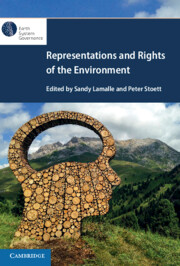16 results
5 - A Common Space of Legal Communication
- from Part I - Challenges
-
-
- Book:
- Representations and Rights of the Environment
- Published online:
- 16 March 2023
- Print publication:
- 06 April 2023, pp 110-144
-
- Chapter
- Export citation
Contributors
-
- Book:
- Representations and Rights of the Environment
- Published online:
- 16 March 2023
- Print publication:
- 06 April 2023, pp xii-xx
-
- Chapter
- Export citation
Contents
-
- Book:
- Representations and Rights of the Environment
- Published online:
- 16 March 2023
- Print publication:
- 06 April 2023, pp vii-viii
-
- Chapter
- Export citation
Dedication
-
- Book:
- Representations and Rights of the Environment
- Published online:
- 16 March 2023
- Print publication:
- 06 April 2023, pp v-v
-
- Chapter
- Export citation
Epigraph
-
- Book:
- Representations and Rights of the Environment
- Published online:
- 16 March 2023
- Print publication:
- 06 April 2023, pp vi-vi
-
- Chapter
- Export citation
Part III - Perspectives
-
- Book:
- Representations and Rights of the Environment
- Published online:
- 16 March 2023
- Print publication:
- 06 April 2023, pp 231-382
-
- Chapter
- Export citation
Preface
-
- Book:
- Representations and Rights of the Environment
- Published online:
- 16 March 2023
- Print publication:
- 06 April 2023, pp xxi-xxii
-
- Chapter
- Export citation
Index
-
- Book:
- Representations and Rights of the Environment
- Published online:
- 16 March 2023
- Print publication:
- 06 April 2023, pp 383-388
-
- Chapter
- Export citation
Illustrations
-
- Book:
- Representations and Rights of the Environment
- Published online:
- 16 March 2023
- Print publication:
- 06 April 2023, pp ix-x
-
- Chapter
- Export citation
Tables
-
- Book:
- Representations and Rights of the Environment
- Published online:
- 16 March 2023
- Print publication:
- 06 April 2023, pp xi-xi
-
- Chapter
- Export citation
Part I - Challenges
-
- Book:
- Representations and Rights of the Environment
- Published online:
- 16 March 2023
- Print publication:
- 06 April 2023, pp 41-144
-
- Chapter
- Export citation
Acknowledgements
-
- Book:
- Representations and Rights of the Environment
- Published online:
- 16 March 2023
- Print publication:
- 06 April 2023, pp xxiii-xxvi
-
- Chapter
- Export citation
Part II - Recollection
-
- Book:
- Representations and Rights of the Environment
- Published online:
- 16 March 2023
- Print publication:
- 06 April 2023, pp 145-230
-
- Chapter
- Export citation
1 - An Introduction
-
-
- Book:
- Representations and Rights of the Environment
- Published online:
- 16 March 2023
- Print publication:
- 06 April 2023, pp 1-40
-
- Chapter
- Export citation
Copyright page
-
- Book:
- Representations and Rights of the Environment
- Published online:
- 16 March 2023
- Print publication:
- 06 April 2023, pp iv-iv
-
- Chapter
- Export citation

Representations and Rights of the Environment
-
- Published online:
- 16 March 2023
- Print publication:
- 06 April 2023



